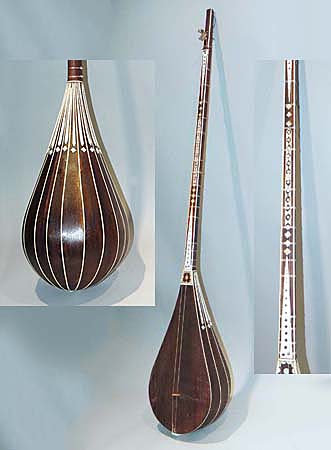
Owner: HWMC
Catalog#: 2AS-CHLT-51
Lutes
Uzbekistan 'Dutar'
Uzbekistan
Uzbek
Mulberry Wood, bone, mother-of-pearl, silk strings, nylon strings
Early-Mid 20th century
Length: 47.5 in; Width: 9.25 in; Depth: 6.75 in
Chordophones – Lutes
The dutar (dutor or dotar) is the main plucked instrument found in Iran and all over Central Asia. Its name comes from the Persian word for “two strings”. When played, the strings are usually plucked by the Uyghurs of Western China and strummed and plucked by the Tajiks, Turkmen, Uzbeks.
This large dutar comes from Uzbekistan. The pear-shaped body is made from separate ribs of mulberry wood, glued together with narrow bone strips between each rib and a highly decorated design connecting to the neck. The flat front resonator body has three sets of small, drilled resonator holes in diamond patterns, and two small holes on either side of the bridge. The long thin neck is highly decorated with inlay bone and mother-of-pearl on the fingerboard and there are 15 nylon tied frets with a straight pegbox at the top. Two flat T-shaped pegs, one on the front, and one on the left are inserted into the pegbox and are used for tuning, which is either a musical interval of a fourth or fifth apart. The two silk strings run over a small wooden bridge that rests on the sound board of the resonator and are loop tied at the bottom.
The dutar is played by strumming and plucking the strings with the right hand, while using the left-hand fingers to stop the bottom string and the thumb for stopping the top string for pitch changes. While it is sometimes played as a solo instrument, it is mainly used to accompany songs.
